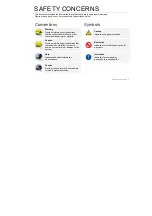
any other adjustment devices are
securely tightened.
Loose adjustment
device can unexpectedly shift, causing loss
of control, loose rotating components will be
violently thrown.
Never start the tool when the bit is
engaged in the material.
The bit cutting
edge may grab the material causing loss of
control of the cutter.
Keep handles dry, clean and free from oil
and grease.
Slippery hands cannot safely
control the power tool.
Always hold the tool with two hands
during start-up
. The reaction torque of the
motor can cause the tool to twist.
When routing or cutting, the direction of
feed with the bit’s cutting edge into the
material is very important. Always feed
the bit into the material in the same
direction as the cutting edge is exiting
from the material.
When viewing the tool
from the top, the bit rotates clockwise. If the
tool is between the workpiece and your body,
then feed the tool to your right. If the
workpiece is between the tool and your body,
then feed the tool to your left. Feeding the
tool in the wrong direction causes the cutting
edge of the bit to climb out of the work and
pull the tool in the direction of this feed.
Never use dull or damaged bits. Sharp
bits must be handled with care.
Damaged
bits can snap during use. Dull bits require
more force to push the tool, possibly causing
the bit to break.
Never touch the bit during or immediately
after the use.
After use the bit is too hot to
be touched by bare hands.
Never lay the tool down until the motor
has come to a complete standstill.
The
spinning bit can grab the surface and pull the
tool out of your control.
Never use bits that have a cutting
diameter greater than the opening in the
base.
Do not use the tool for drilling purposes.
This tool is not intended to be used with drill
bits.
Always use the tool with the depth guide
securely attached and positioned flat
against material being cut.
The guide
securely positioned on the material improves
the stability and control of your tool.
Some dust created by
power sanding, sawing,
grinding, drilling, and other construction
activities contains chemicals known to
cause cancer, birth defects or other
reproductive harm. Some examples of
these chemicals are:
• Lead from lead-based paints,
• Crystalline silica from bricks and cement and
other masonry products, and
• Arsenic and chromium from chemically-
treated lumber.
Your risk from these exposures varies,
depending on how often you do this type of
work. To reduce your exposure to these
chemicals: work in a well ventilated area, and
work with approved safety equipment, such as
those dust masks that are specially designed
to filter out microscopic particles.
BIT
WORK
DIRECTION OF
FEED
START
HERE
Battery/Charger
Before using battery charger, read all
instructions and cautionary markings on
(1) battery charger, (2) battery pack, and (3)
product using battery.
Use only the charger which accompanied
your product or direct replacement as
listed in the catalog or this manual.
Do not
substitute any other charger. Use only Bosch
-4-
!
WARNING
RZ 2610955692 11-08:RZ 2610955692 11-08 11/10/08 9:24 AM Page 4





































